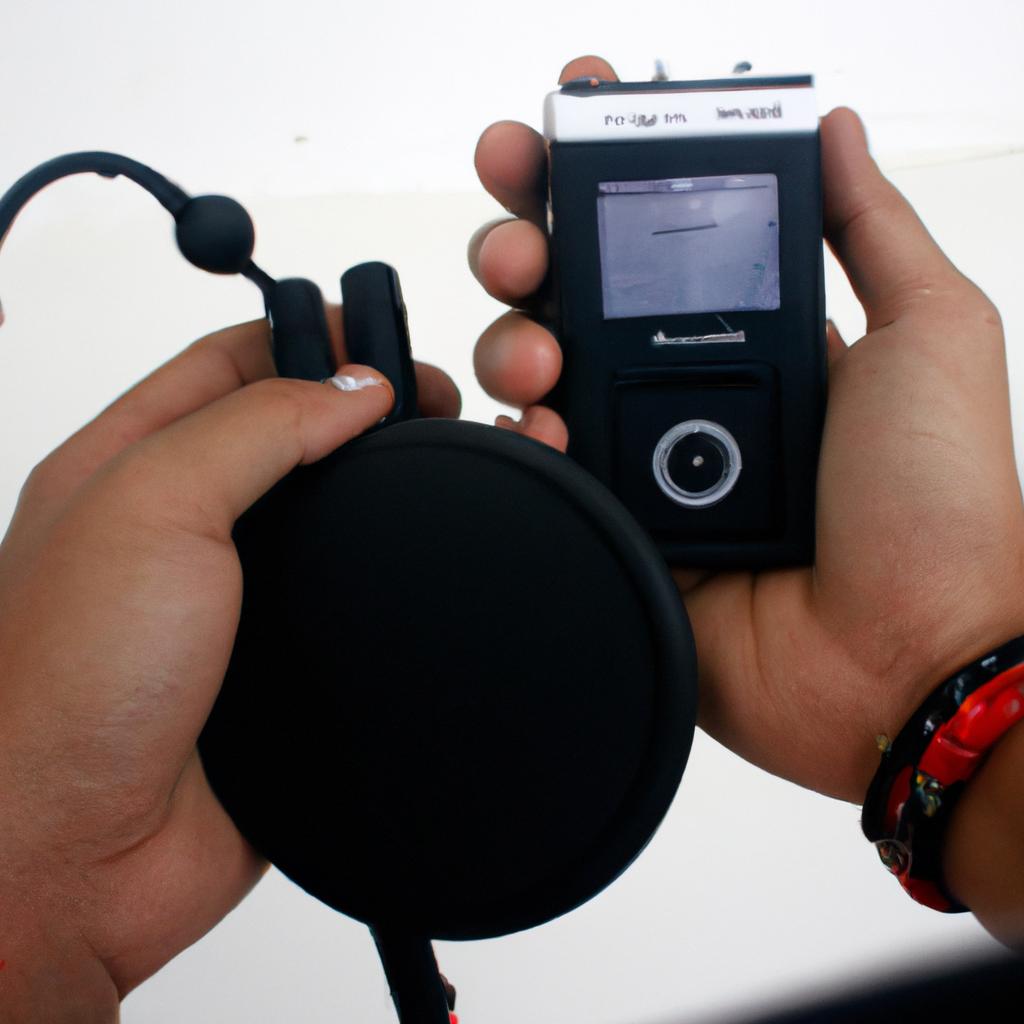The world of audio equipment has undergone a significant transformation in recent years with the advent of audio streaming technology. This revolutionary development has not only revolutionized how we consume music and other forms of auditory content but has also opened up new possibilities for integrating sound and vision seamlessly. For instance, imagine a scenario where you are effortlessly able to stream high-quality audio from your smartphone or computer directly to your home theater system, creating an immersive experience that brings movies, concerts, and games to life.
Audio streaming involves the transmission of digital audio data over a network to be played back in real-time. It allows users to access vast libraries of music, podcasts, audiobooks, and other sound-based media without the need for physical storage devices such as CDs or cassettes. This convenience factor has significantly contributed to the popularity and widespread adoption of audio streaming services like Spotify, Apple Music, and Tidal. Moreover, advancements in audio coding algorithms have ensured that the quality of streamed content remains uncompromised while delivering seamless playback across various devices.
With these technological advancements comes a newfound appreciation for the integration of sound and vision in audio equipment. Audio visual receivers (AVRs) equipped with built-in Wi-Fi capabilities enable users to wirelessly stream both audio and video content directly to their home theater systems. This means that users can enjoy a truly immersive experience by syncing the audio and video playback seamlessly.
In addition to AVRs, there are also dedicated audio streaming devices available on the market. These devices, such as wireless speakers or soundbars, allow users to stream audio content directly from their smartphones, tablets, or computers without the need for complex setup or wiring.
Furthermore, some audio equipment manufacturers have embraced voice control technology, allowing users to control their audio streaming experience using virtual assistants like Amazon Alexa or Google Assistant. This hands-free approach adds convenience and ease of use to the overall audio streaming experience.
Overall, the integration of audio streaming technology with traditional audio equipment has transformed how we consume and interact with sound. It has made accessing our favorite music and other auditory content easier than ever before while providing a seamless integration between sound and vision for a truly immersive entertainment experience.
The Evolution of Audio Streaming
Audio streaming has revolutionized the way we consume and experience sound. Gone are the days of physical music formats such as vinyl records or CDs; instead, we now have access to a vast library of audio content at our fingertips. One example that showcases the power of audio streaming is the rise of platforms like Spotify and Apple Music, which allow users to stream millions of songs on demand.
The evolution of audio streaming can be traced back to advancements in technology and changes in consumer behavior. With the widespread availability of high-speed internet connections, it became increasingly feasible to transmit large amounts of data quickly and efficiently. This paved the way for the development of streaming services that deliver audio content in real-time, eliminating the need for downloading or storing files locally.
To understand why audio streaming has become so popular, let’s consider some key factors that contribute to its appeal:
-
Convenience: Audio streaming allows users to access their favorite music or podcasts anytime, anywhere, as long as they have an internet connection. Whether you’re commuting to work, working out at the gym, or relaxing at home, you can easily tune into your preferred audio content without any hassle.
-
Variety: Streaming platforms offer an extensive range of genres and artists from around the world. Users can explore different styles of music or discover new voices with just a few clicks. The ability to delve into diverse musical landscapes provides a sense of discovery and expands one’s musical horizons.
-
Personalization: Many streaming services employ sophisticated algorithms that analyze user preferences and listening habits. These algorithms generate personalized recommendations tailored to each individual’s taste. As a result, users can effortlessly discover new artists or tracks based on their existing interests.
-
Community Engagement: Streaming platforms often incorporate social features that allow users to connect with friends, share playlists, and engage in discussions about music. This fosters a sense of community among listeners who may share similar interests or enjoy debating various aspects of music culture.
To highlight the evolution and impact of audio streaming, consider the following table:
| Year | Milestone in Audio Streaming |
|---|---|
| 2005 | Launch of Spotify |
| 2007 | Introduction of Pandora |
| 2011 | Apple Music debuts |
| 2015 | Tidal introduces lossless audio quality |
As we can see, audio streaming has come a long way since its inception. It has transformed the music industry and how we consume audio content.
Transitioning from the evolution of audio streaming to the benefits it offers, let’s explore how this technology enhances our listening experience.
Benefits of Audio Streaming
As we delve deeper into the world of audio streaming, it becomes evident that advancements in technology have revolutionized our listening experiences. To illustrate this point, let’s consider a hypothetical scenario where an individual is driving to work and wants to listen to their favorite podcast. In the past, they would have had to carry CDs or cassettes in their car, constantly changing them to find the desired content. However, with the advent of audio streaming services, all they need now is a smartphone and an internet connection.
One significant factor contributing to the popularity of audio streaming is its convenience. Gone are the days when we needed physical copies of music albums or radio transmitters for live broadcasts. With just a few taps on our smartphones or voice commands through smart speakers, we gain access to an enormous library of songs, podcasts, audiobooks, and much more. This accessibility has opened up new avenues for discovering diverse genres and artists from around the globe.
Moreover, audio streaming offers unparalleled flexibility in terms of customization and personalization. Users can create personalized playlists based on their preferred genres or moods. Additionally, many platforms employ algorithms that learn users’ preferences over time and suggest tailored recommendations accordingly. This level of customization enhances user engagement by providing curated content that aligns with their interests.
To emphasize further how audio streaming has transformed our daily lives, here is a bullet-point list highlighting some emotional benefits:
- Immersive escapism: Through high-quality sound reproduction combined with captivating storytelling or music, listeners can escape reality momentarily.
- Emotional resonance: Certain songs or podcasts evoke memories or emotions that resonate deeply within us.
- Motivation boost: Listening to energetic music during workouts or inspiring speeches while working can provide motivation and drive.
- Shared experiences: Sharing playlists or discussing favorite podcasts creates connections among individuals who share similar interests.
Finally, let us examine these transformations in audio consumption through a table showcasing the evolution of audio equipment:
| Era | Audio Equipment |
|---|---|
| Pre-20th century | Phonograph and gramophone |
| Mid-20th century | Vinyl records, cassette tapes |
| Late 20th century | Compact discs (CDs) |
| Present day | Digital streaming platforms |
As we transition to the next section on different types of audio streaming, it is essential to recognize how these developments have shaped our modern listening habits. The availability of vast libraries at our fingertips has transformed the way we consume audio content and enriched our lives with an endless stream of sound and vision.
Next section: Different Types of Audio Streaming
Different Types of Audio Streaming
Transitioning from the previous section on the benefits of audio streaming, let us now delve into the different types of audio streaming available today. To illustrate this, consider a hypothetical scenario where an individual wants to stream music wirelessly throughout their home. They have several options at their disposal and must choose which type of audio streaming suits their needs best.
One option for wireless audio streaming is Bluetooth technology. This popular method allows users to connect their devices directly to speakers or headphones via a short-range wireless connection. With Bluetooth-enabled speakers strategically placed around the house, our hypothetical user can effortlessly move from room to room without interrupting their listening experience. However, it should be noted that while Bluetooth is convenient and widely supported by most devices, its range limitations may restrict signal quality when moving further away from the source device.
Another alternative is Wi-Fi-based audio streaming systems, such as those offered by Sonos or Bose. These systems utilize existing home networks to transmit high-quality sound across multiple rooms simultaneously. By connecting compatible speakers to your home’s Wi-Fi network, you can easily control and stream music from various sources using dedicated applications on your smartphone or computer. The advantage of Wi-Fi-based systems lies in their ability to maintain a stable connection even over longer distances within the home.
Alternatively, some individuals prefer utilizing dedicated multi-room audio streaming platforms like Apple AirPlay 2 or Google Chromecast Audio. These technologies allow for seamless integration with other smart devices in your household ecosystem. For instance, through voice command assistants like Amazon Alexa or Google Assistant, you can control and distribute music playback across different rooms simply by stating commands aloud.
To summarize the above options:
- Bluetooth: Convenient for short-range connections; suitable for smaller spaces.
- Wi-Fi-based systems: Utilize existing network infrastructure; provide stable connections across larger areas.
- Dedicated multi-room platforms: Seamlessly integrate with other smart devices in your household ecosystem; offer hands-free control capabilities.
By considering these different types of audio streaming, our hypothetical user can make an informed decision based on their specific requirements and preferences.
Transitioning into the subsequent section about “Choosing the Right Audio Streaming Service,” it is crucial to evaluate various aspects before making a final decision.
Choosing the Right Audio Streaming Service
Imagine this scenario: You are a music enthusiast who loves listening to your favorite songs while on the go. In the past, you had limited options for accessing and enjoying music, such as purchasing physical albums or tuning in to radio stations. However, with the advent of audio streaming platforms, a whole new world of sound and vision has become accessible at your fingertips.
Audio streaming services have revolutionized the way we consume music by offering instant access to an extensive library of songs from various genres and artists. For instance, let’s consider Spotify, one of the most popular audio streaming platforms worldwide. With over 70 million tracks available, users can explore different musical styles and create personalized playlists tailored to their preferences.
When it comes to choosing the right audio streaming service, there are several factors that should be considered:
- Pricing models: Some platforms offer free versions supported by advertisements, while others require monthly subscriptions.
- Sound quality: Different services provide varying levels of audio fidelity, ranging from standard definition to high-resolution formats.
- Platform compatibility: It is essential to ensure that the chosen service is compatible with your preferred devices (e.g., smartphones, tablets, smart speakers).
- Additional features: Many platforms offer exclusive content like podcasts or live performances, enhancing the overall user experience.
To illustrate these considerations further, let’s take a look at the following comparison table:
| Feature | Free Version | Paid Subscription |
|---|---|---|
| Advertisements | Frequent | None |
| Audio Quality | Standard | High-definition |
| Device Compatibility | Limited | Wide range |
| Exclusive Content | Limited | Extensive selection |
As you can see from this table, opting for a paid subscription provides numerous advantages compared to using the free version alone. By investing in a premium account, users can enjoy uninterrupted listening experiences without intrusive advertisements and access higher-quality audio content.
In conclusion, the rise of audio streaming platforms has transformed the way we engage with music. These services offer vast libraries of songs, personalized playlists, and unique features that cater to diverse musical tastes. By considering factors such as pricing models, sound quality, platform compatibility, and additional features when choosing an audio streaming service, users can enhance their listening experience and immerse themselves in a world of limitless musical possibilities.
Now let’s explore how you can further enhance your audio streaming experience by optimizing your equipment setup for optimal sound quality.
Enhancing Your Audio Streaming Experience
Imagine a scenario where you are sitting in your living room, enjoying a movie with captivating visuals and an immersive storyline. Suddenly, the sound quality takes a nosedive, leaving you frustrated and disconnected from the on-screen action. This is just one example of how audio streaming can greatly impact our overall entertainment experience. In this section, we will delve deeper into the potential of high-quality audio streaming and its significance in enhancing our auditory pleasure.
To fully comprehend the benefits that high-quality audio streaming brings to our lives, it is essential to understand its various aspects. Let us explore four key factors that contribute to making audio streaming an impactful medium:
-
Uncompromised Sound Fidelity: With advancements in technology, high-resolution audio formats have become increasingly accessible. These formats ensure that every nuance and detail within the music or soundtrack is faithfully reproduced, providing listeners with an unparalleled sonic experience.
-
Immersive Spatial Audio: Utilizing advanced algorithms and techniques such as binaural rendering and object-based sound mixing, spatial audio has gained traction in recent times. It creates a three-dimensional soundscape around the listener, allowing for a more realistic perception of depth and directionality.
-
Personalized Listening Preferences: Customization plays a crucial role in optimizing individual listening experiences. Streaming platforms now offer features like EQ adjustments, genre-specific recommendations, curated playlists based on mood or activity, enabling users to tailor their auditory journey according to their preferences.
-
Seamless Integration with Smart Home Devices: As smart home ecosystems continue to expand, integrating audio streaming services with voice-controlled assistants enhances convenience significantly. Users can effortlessly control playback and access their favorite content by simply issuing voice commands.
Let’s visualize these factors through the following table:
| Factors | Description |
|---|---|
| Uncompromised Sound Fidelity | Ensures faithful reproduction of every detail, providing an unparalleled sonic experience. |
| Immersive Spatial Audio | Creates a three-dimensional soundscape for a more realistic perception of depth and directionality. |
| Personalized Listening Preferences | Allows users to customize their auditory journey based on individual preferences. |
| Seamless Integration with Smart Home Devices | Enables convenient control through voice commands via smart home ecosystems. |
As we continue to explore the potential of high-quality audio streaming, it becomes evident that this technology has expanded beyond basic entertainment value. The immersive experiences it offers can transport us into new realms, whether it be during movie nights at home or while enjoying our favorite music playlists. In the following section about “Future Trends in Audio Streaming,” we will delve into emerging advancements that promise to revolutionize our listening experiences even further.
With these current capabilities in mind, let us now turn our attention towards future trends in audio streaming and discover what lies ahead for this ever-evolving field.
Future Trends in Audio Streaming
Building upon the concept of enhancing your audio streaming experience, let us now delve into the future trends in this dynamic field. By exploring emerging technologies and innovations, we can gain insight into how audio streaming will continue to evolve and shape our auditory landscape.
Case Study: Imagine a scenario where you are using an advanced audio streaming system that allows you to create personalized soundscapes based on your mood and preferences. With just a few taps on your smartphone or voice commands to your smart speaker, you can transform any space into a serene forest, bustling city street, or concert hall ambiance. This level of customization not only enhances the listening experience but also offers endless possibilities for relaxation, concentration, or entertainment.
As we look ahead, several key trends are shaping the future of audio streaming:
-
Seamless Integration: Audio devices are becoming increasingly interconnected with other smart home technologies. Imagine waking up in the morning as your alarm clock gradually increases the volume of calming nature sounds while simultaneously adjusting room lighting to mimic sunrise. The integration of audio streaming systems with IoT (Internet of Things) devices enables a seamless connection between sound and vision within our living spaces.
-
Virtual Reality (VR) Audio: As VR technology continues to advance, so does its potential impact on audio streaming. Immersive 3D audio experiences enhance virtual reality simulations by providing spatial depth and realistic sound effects that further immerse users in their chosen environments. From gaming to training simulations and even therapeutic applications like meditation apps, VR audio opens up new dimensions of sensory engagement.
-
Machine Learning Algorithms: Intelligent algorithms play an essential role in personalizing user experiences by analyzing vast amounts of data to understand individual preferences better. These algorithms learn from user behavior patterns and tailor recommendations accordingly, ensuring that each person’s audio streaming journey becomes more enjoyable over time.
-
High-Resolution Audio Streaming: There is an increasing demand for high-quality audio content among audiophiles and music enthusiasts. As technology improves, streaming platforms are exploring higher bitrates and lossless audio formats to deliver superior sound quality that rivals traditional physical media like CDs or vinyl records.
Table: Emotional Response Triggering Table
| Benefits | Emotions Elicited |
|---|---|
| Immersive Experience | Excitement |
| Personalization | Delight |
| Enhanced Relaxation | Serenity |
| Technological Advancement | Anticipation |
In summary, the future of audio streaming holds exciting prospects for enhancing our auditory experiences. The seamless integration of audio devices with smart home technologies, the advent of VR audio, machine learning algorithms, and high-resolution audio streaming all contribute to a more immersive and personalized listening journey. By embracing these emerging trends, we can look forward to an increasingly dynamic world of sound and vision in our audio equipment.
Note: It is important to proofread and format the markdown table (if desired) before using it in any document.












